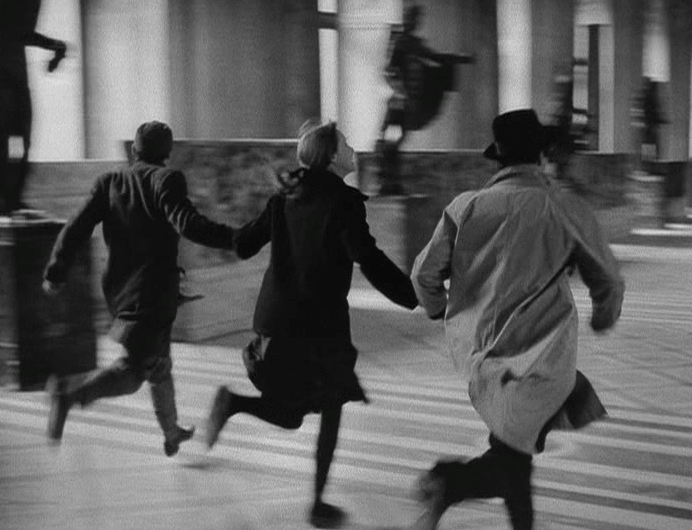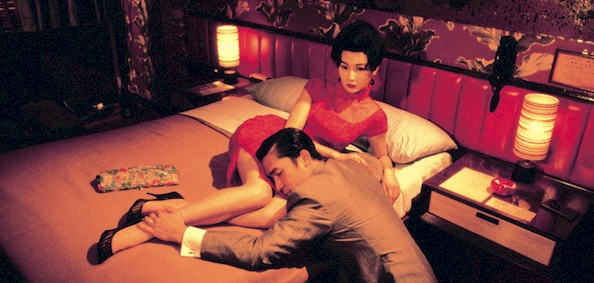European Art Cinema
Post-WWII, often attempting a more radical approach to narrative, featuring the use of psychology and intense characterizations over plot. The question is not "What's going to happen next?", but instead "Why is this happening?". Various "new wave" movements sprung up during the 1960s, lead by young filmmakers who reacted against what Cahiers du cinéma called "daddy's cinema".
8 1/2 (Federico Fellini, 1963, Italy)
One of the towering achievements of cinematic history, Fellini's elliptical, wandering, ambitious and surreal film is an art house epic. Hugely influential, this film is among the most difficult on this list for some audiences, while others will eat this epic up.
The Seventh Seal (Ingmar Bergman, 1957, Sweden)
A good introduction to the stoic cinema of Sweden's premier auteur, Ingmar Bergman. A medieval knight goes on his business while being stalked by Death himself as they play a game of chess.
Ali: Fear Eats the Soul (Rainier Werner Fassbinder, 1974, West Germany)
Fassbinder was one of the most prolific directors out there, but this surely ranks as his most heart-wrenching yet accessible of his work. Excellent performances dominate.
Shoot the Piano Player (François Truffaut, 1960, France)
Truffaut's thriller-comedy-tragedy of a second feature film is far more playful than his seminal debut The 400 Blows (1959), but still features many of the same qualities that made the French New Wave so integral to film history.
Band of Outsiders (Jean-Luc Godard, 1964, France)
Like Shoot the Piano Player, this is Godard at his most playful and loose. Anna Karina, Godard's future wife, is simply delightful in every film she appears in, but rarely moreso than here. Look for an impromptu dance sequence that surely ranks as one of the most marvellous sequences in cinema.
American New Wave/The New Hollywood
Young filmmakers react to Classical Hollywood and the collapse of the Production Code that forbade many 'controversial' topics and their depiction.
Taxi Driver (Martin Scorsese, 1976)
Robert DeNiro's iconic performance as Travis Bickle is only one part of Scorsese's haunting masterpiece. It's dark, gritty, melancholic and profoundly disturbing -- and yet somehow supremely entertaining.
Blue Velvet (David Lynch, 1986)
Although too late to be considered a true member of the New Hollywood, Blue Velvet remains one of the most integral of American films. Similar to Taxi Driver in that it's the disturbing portrait of the evil that lurks under the veneer of the American Dream, Lynch's masterpiece is a surreal mystery film with some of the greatest performances out there. Dennis Hopper truly disturbs as the unknown-gas-sniffing, sexual deviant and psychotic Frank Booth: one of cinema's greatest villains.
M*A*S*H (Robert Altman, 1970)
A little bit different than the spin-off television series, Altman's film is more biting, satirical and even a little bit bawdy -- but always worth a good belly laugh.
Annie Hall (Woody Allen, 1977)
This Best Picture winner is sometimes maligned by fanboys as the film that beat Star Wars for the Oscar, but it's difficult to argue after having seen it. Hilarious from start to finish, with some miraculous filmmaking skill and wonderful non-sequiters. Diane Keaton justly won the Academy Award for her iconic performance as the titular Annie Hall.
The Last Picture Show (Peter Bogdanovich, 1971)
This stark coming-of-age tale was one of the major breakthroughs of the New Hollywood. A melancholic and moving view of a small mid-west town, with strong performances and homages to Classical Hollywood cinema.
Although too late to be considered a true member of the New Hollywood, Blue Velvet remains one of the most integral of American films. Similar to Taxi Driver in that it's the disturbing portrait of the evil that lurks under the veneer of the American Dream, Lynch's masterpiece is a surreal mystery film with some of the greatest performances out there. Dennis Hopper truly disturbs as the unknown-gas-sniffing, sexual deviant and psychotic Frank Booth: one of cinema's greatest villains.
M*A*S*H (Robert Altman, 1970)
A little bit different than the spin-off television series, Altman's film is more biting, satirical and even a little bit bawdy -- but always worth a good belly laugh.
Annie Hall (Woody Allen, 1977)
This Best Picture winner is sometimes maligned by fanboys as the film that beat Star Wars for the Oscar, but it's difficult to argue after having seen it. Hilarious from start to finish, with some miraculous filmmaking skill and wonderful non-sequiters. Diane Keaton justly won the Academy Award for her iconic performance as the titular Annie Hall.
The Last Picture Show (Peter Bogdanovich, 1971)
This stark coming-of-age tale was one of the major breakthroughs of the New Hollywood. A melancholic and moving view of a small mid-west town, with strong performances and homages to Classical Hollywood cinema.
Silent Cinema
While there are many places to begin with an incredible wealth of material, it seems that many audiences either don't know where to begin or are hesitant to start, afraid that they will be bored.
Nosferatu (FW Murnau, 1922, Germany)
This unauthorized version of Dracula was almost completely destroyed by Bram Stoker's widow. Thankfully, she didn't succeed, and we now have the ability to see one of the most entertaining and effective of all silent films. Max Schreck's remarkable performance as the vampire has become the stuff of legend, with fanciful suggestions that he was indeed a vampire himself (the basis of the 2000 film Shadow of the Vampire): how else can you explain those hypnotic, unearthly movements, and that incredible stare and makeup?
Metropolis (Fritz Lang, 1927, Germany)
More hypnotic movements in this German Expressionist masterpiece and one of the most influential science fiction pieces. The narrative is near-mythic in its battle of good and evil, but it's the massive visuals and the towering art direction that make this a must-see for anyone who considers themselves a lover of cinema.
The Red Spectre (Sigundo de Chomón and Ferdinand Zecca, 1907, Spain)
This is one of my professor Tobias and mine favourite films, and a perfect example of what Tom Gunning calls the Cinema of Attraction. A devil-like figure performs tricks and magic.
Un Chien Andalou (Luis Buñuel and Salvador Dalì, 1929, France/Spain)
No art house list would be complete without Un Chien Andalou. Just watch it, and don't read anything about it before you do. You'll, uh, thank me.
Three East Asian Films
Late Spring (Yasujiro Ozu, 1949, Japan)
Ozu's meditative style is often called the 'most Japanese' of his peers, with a purposeful but slow pace and muted yet strong emotions. Late Spring may be considered by many as lesser than his masterpiece Tokyo Story, but I find the film to be one of the emotionally powerful films ever made. A widowed father watches as his only daughter goes through the milestone of marriage.
In the Mood for Love (Wong Kar Wai, 2000, Hong Kong)
Contemporary Hong Kong auteur Wong Kar Wai made quite a splash with this film just over a decade ago. It's oozing with passion from every shot, and the romance is humid yet never quite consummated. A beautiful film.
Rashomon (Akira Kurosawa, 1950)
One of my personal favourites, Rashomon is Kurosawa at his most focused and inventive. Multiple people have witnessed a murder, but each have different stories to tell of exactly what happened. Who is telling the truth? Is there any way that we can determine this?

















No comments:
Post a Comment